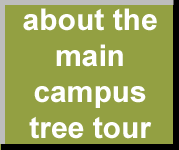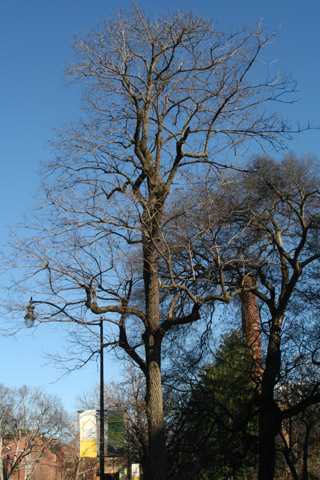
|

|

|

|
An individual instance of Diospyros virginiana (common persimmon)

Permanent unique identifier for this particular organism:
http://bioimages.vanderbilt.edu/vanderbilt/10-65
Notes:
This tree is along Vanderbilt Place where the Branscomb Quadrangle dropoff drive joins the street on the side nearest the main campus.
Persommon leaves are not very distinctive. They have no lobes and have smooth margins. They are sometimes confused with the leaves of black gum. The bark of all but the smallest trees will distinguish the two species. Persimmon bark looks like alligator skin, with the bark splitting into square lumps. Black gum bark is more ridged. The leaf scar of persimmon has one banana-shaped bundle trace, while the black gum leaf scar has three round bundle traces. If fruit is present in the fall, the two also look quite different. Persimmon fruit is a large, edible, orange to black berry. Black gum fruit is smaller and bluish-black.
Persimmon is a fairly common tree in middle Tennessee. Small mammals are known to gorge themselves on the piles of persimmon fruit under a large tree loaded with fruit. Note that persimmons are dioecious (separate male and female trees), so if a tree is a male, it will never produce fruit. This particular tree is a female. It receives pollen from a nearby male.
This tree is described on p. 55 of The Trees of Vanderbilt.
Persommon leaves are not very distinctive. They have no lobes and have smooth margins. They are sometimes confused with the leaves of black gum. The bark of all but the smallest trees will distinguish the two species. Persimmon bark looks like alligator skin, with the bark splitting into square lumps. Black gum bark is more ridged. The leaf scar of persimmon has one banana-shaped bundle trace, while the black gum leaf scar has three round bundle traces. If fruit is present in the fall, the two also look quite different. Persimmon fruit is a large, edible, orange to black berry. Black gum fruit is smaller and bluish-black.
Persimmon is a fairly common tree in middle Tennessee. Small mammals are known to gorge themselves on the piles of persimmon fruit under a large tree loaded with fruit. Note that persimmons are dioecious (separate male and female trees), so if a tree is a male, it will never produce fruit. This particular tree is a female. It receives pollen from a nearby male.
This tree is described on p. 55 of The Trees of Vanderbilt.

|

|
|
Load database and switch to thumbnail view
Use this stable URL to link to this page:
http://bioimages.vanderbilt.edu/vanderbilt/10-65.htm
This organism is a living specimen that is part of the Vanderbilt University Arboretum with the local identifier 4-733.
This particular organism is believed to have managed means of establishment.
This organismal entity has the scope: multicellular organism.
Remarks: Individual is a female.
Identifications:
Diospyros virginiana
L.
sec. fna.org 1993
common name: common persimmon
family: Ebenaceae
Identified 2002-09-09 by Steven J. Baskauf
Location:
Vanderbilt University, Nashville, Davidson County, Tennessee, US
Click on these geocoordinates to load a map showing the location: 36.14548°, -86.80535°
Coordinate uncertainty about: 10 m.
Location of individual determined from GIS database.
Occurrences were recorded for this particular organism on the following dates:
2002-09-09
2006-05-15
2013-12-11
2014-09-03
The following images document this particular organism.
Click on a thumbnail to view the image and its metadata. Load database and enable navigation by taxon and organism.
| Image | View |

|
whole tree (or vine) - winter |

|
inflorescence - unspecified |

|
fruit - lateral or general close-up |

|
whole tree - general |